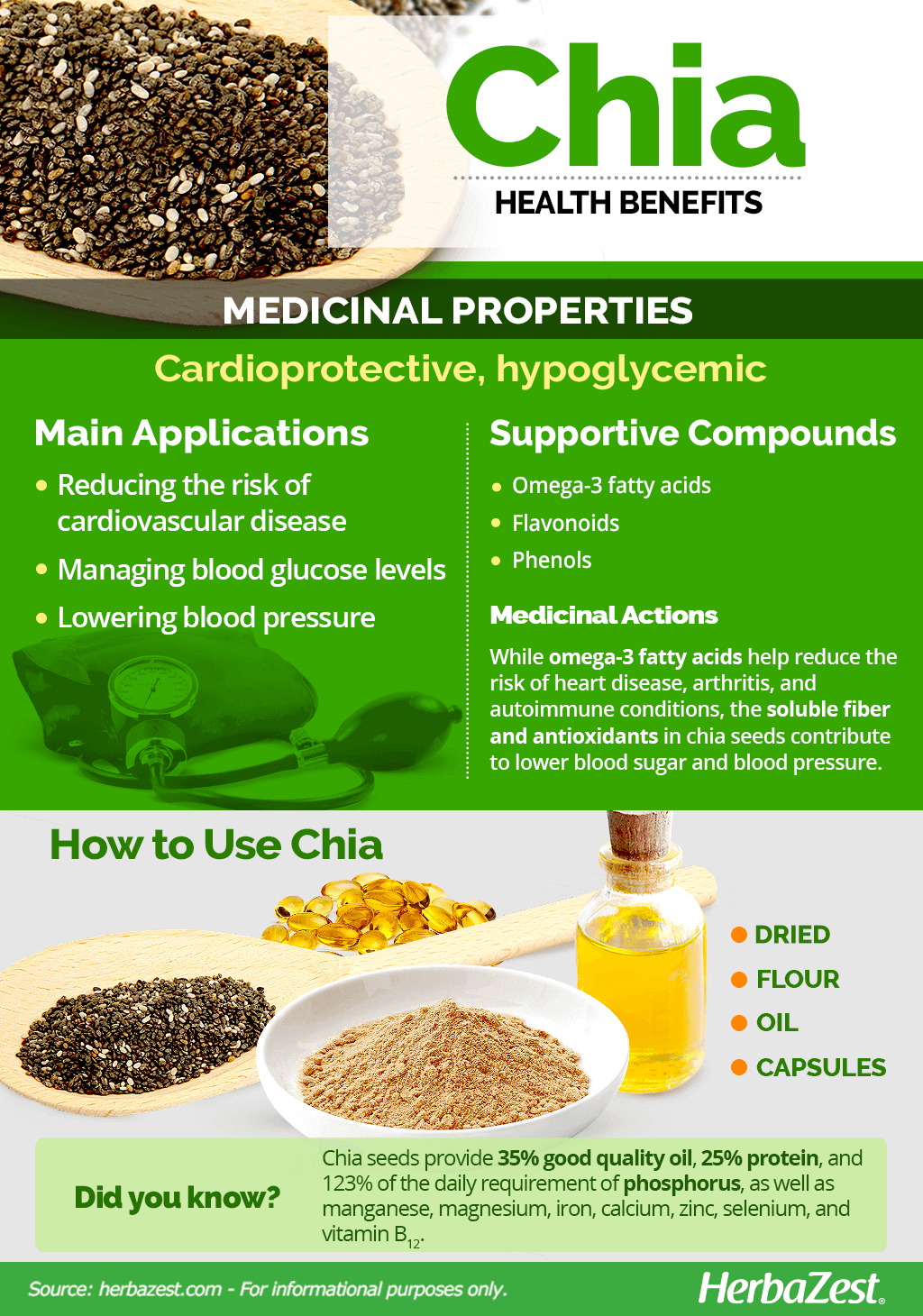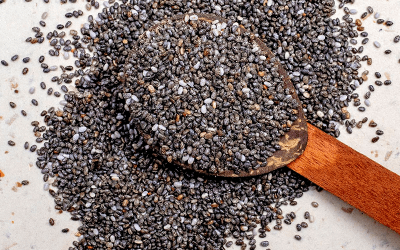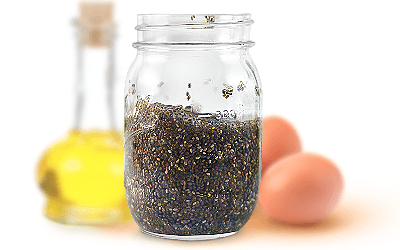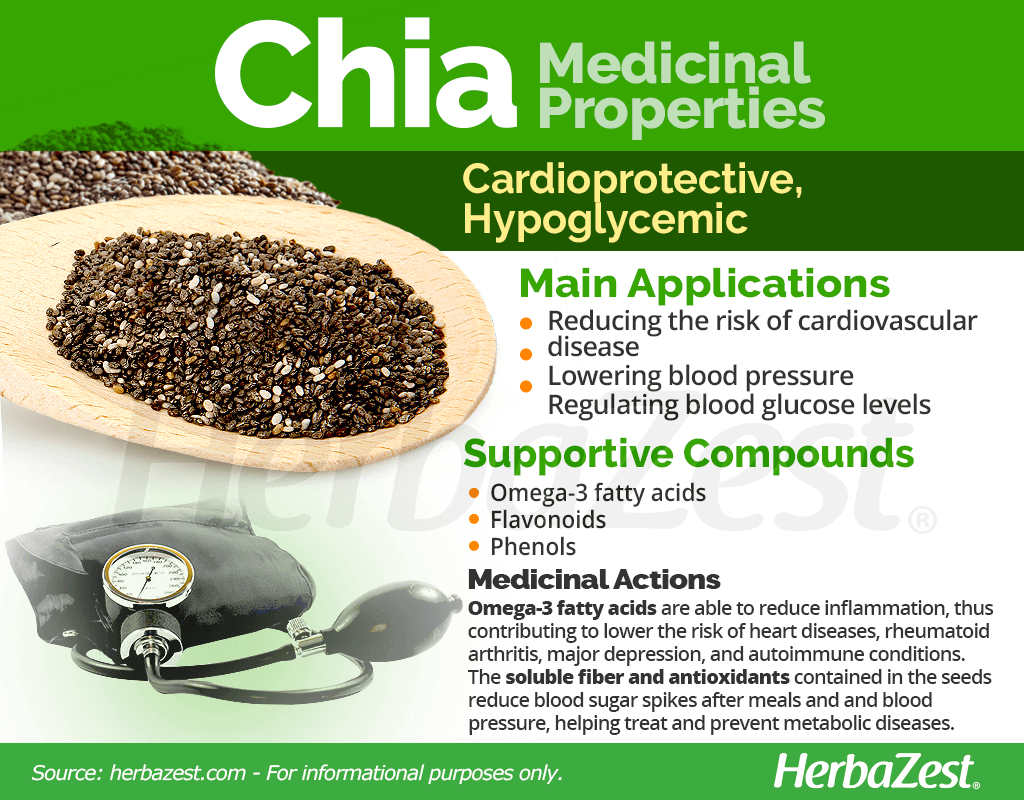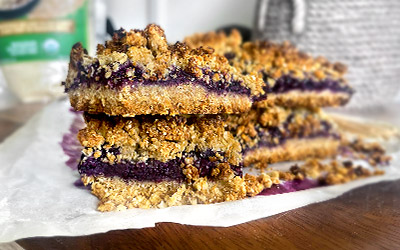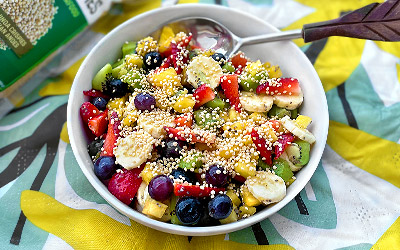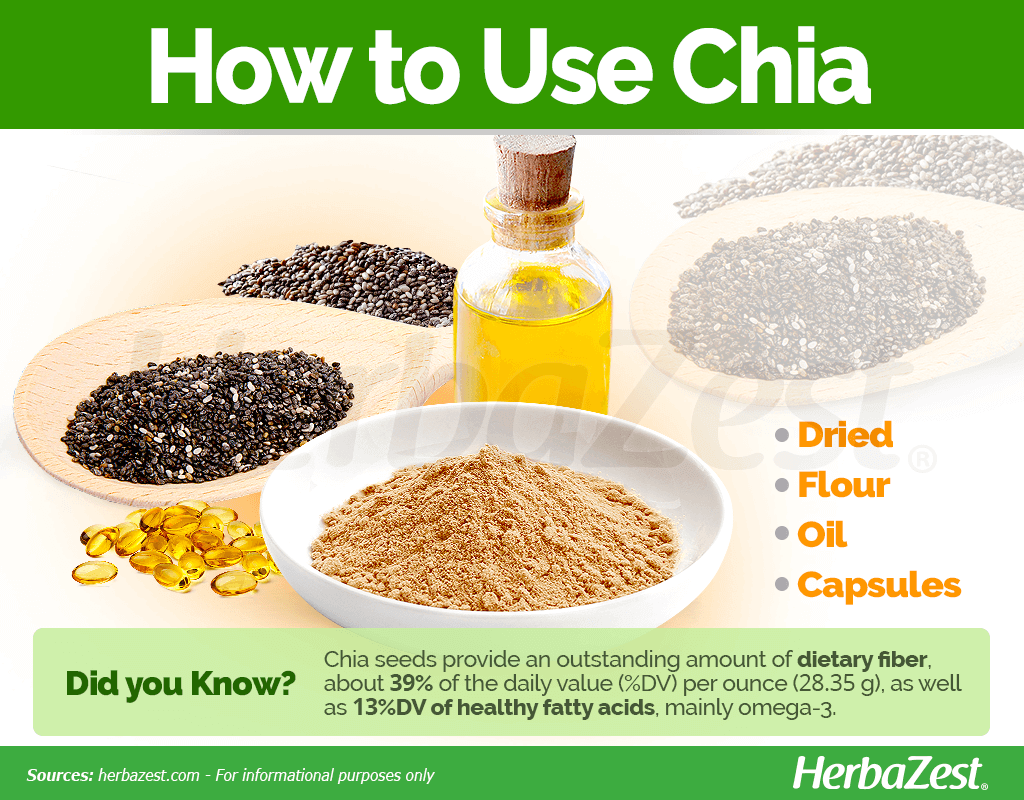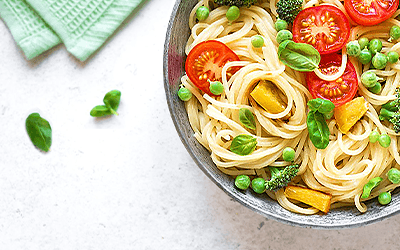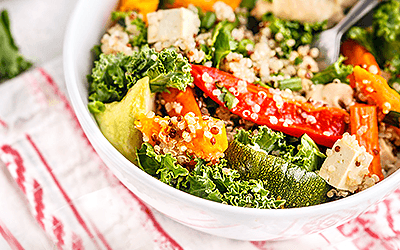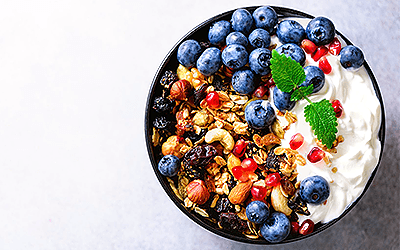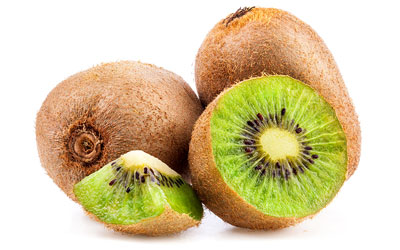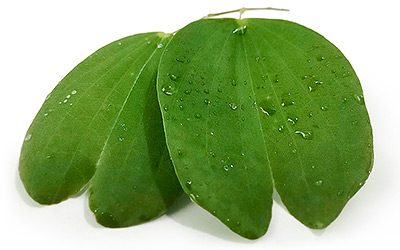Hailing from the temperate climates of Mexico and northern Central America, chia has been scientifically dated as being present in its native regions as far back as 3500 BCE. By 2600 BCE, it was already an established food crop for indigenous civilizations. Its common name comes from the Nahuatl word chian, meaning "oily."
Chia Medicinal Properties
- Medicinal action Cardioprotective, Hypoglycemic
- Key constituents Omega-3 fatty acids, flavonoids, phenols
- Ways to use Capsules, Powder, Essential oil
- Medicinal rating (3) Reasonably useful plant
- Safety ranking Safety undetermined
Health Benefits of Chia
Little research has been conducted into chia to support its uses. Nevertheless, due to reports of its rich nutrient content and antioxidant action, the following medicinal uses are being examined:
Reducing the risk of cardiovascular disease. Thanks to their richness in omega-3 fatty acids and fiber, chia seeds help decrease the likelihood of developing heart disease.
Lowering blood pressure. It has been shown that chia seeds help reduce blood pressure in people with hypertension, thus promoting heart health.1
Managing blood glucose levels. Several clinical trials have shown that both whole and ground chia seeds have hypoglycemic properties.2
Maintaining a healthy weight. Snacking on chia seeds may reduce hunger and induce satiety, which can be helpful for losing and maintaining a healthy weight.
How It Works
The major supporting compounds in chia are omega-3 fatty acids, phenols, and flavonoids, all with antioxidant and anti-inflammatory properties.
Many studies have shown that omega-3 fatty acids possess potent immunomodulatory activities, which are able to inhibit interleukin 1 (IL-1), a proinflammatory cytokine, thus contributing to lower the risk of coronary heart disease, rheumatoid arthritis, major depression, and other autoimmune conditions, such as arthritis, Crohn's disease, ulcerative colitis, psoriasis, lupus erythematosus, multiple sclerosis, and migraine headaches.
The exact mechanism behind the hypoglycemic properties of chia is yet to be fully explained; however, studies suggest that the soluble fiber and antioxidants contained in the seeds reduce postprandial glycemia and blood pressure, helping with the prevention and treatment of metabolic diseases, such as hypertension, high cholesterol, and diabetes.
Hypotensive properties are also present in saffron and goji berry, whereas carambola and graviola can provide hypoglycemic benefits.
Chia Side Effects
Chia is generally regarded as safe for consumption by people who are not allergic to it. However, it is recommended that chia consumption not exceed 48 grams a day to avoid adverse effects.
Chia Nutrition
Chia seeds are bursting with nutritional value. In addition to be an excellent source of minerals, mainly manganese, necessary for the metabolism of carbohydrates, as well as for promoting calcium absorption and regulating blood sugar levels; selenium, which protects the integrity of the cells and supports thyroid hormone metabolism; copper, crucial for the generation of new red blood cells and essential for bodily functions; magnesium, an important nutrient that supports energy production and blood pressure regulation; and phosphorus, which help in the metabolism of carbohydrates and fats, as well as in protein production.
The nutritional profile of chia seeds is rounded by good amounts of vitamins B3 (niacin) and B1 (thiamin), as well as minerals, including calcium, iron, and zinc. The combined action of these nutrients contributes to support immunity, bone mineral density, neurological functions, and red blood cells production.
An ounce of chia seeds (28.35 g) provides 138 calories and an impressive 39% of the daily value for dietary fiber.
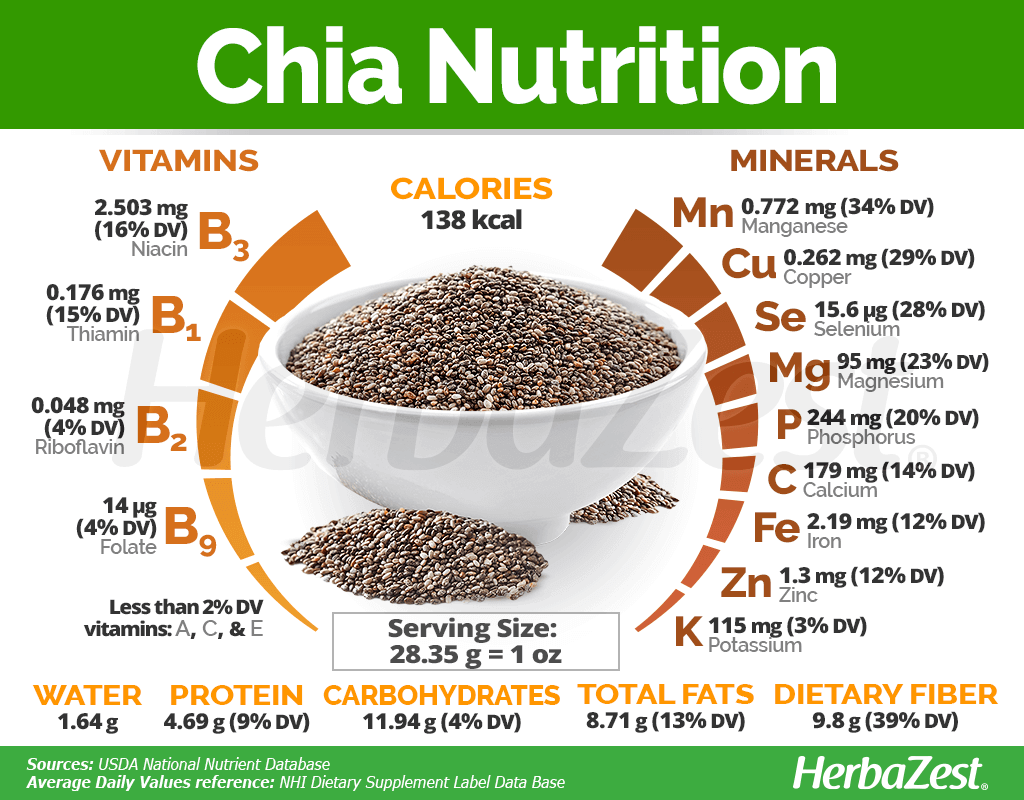
How to Consume Chia
- Edible parts Seed
Chia seeds are the most commonly consumed part of the plant, though chia sprouts can also be eaten as a vegetable.
Natural Forms
Dried. Chia seeds can be mixed into smoothies, sprinkled onto yogurt and salads for a nutritional kick. Chia puddings are a great way to consume the mucilaginous seeds and take advantage of their health benefits.
Flour. Consuming chia flour tends to raise the body's omega-3 fatty acid levels more than whole chia seeds, and contribute to lower blood pressure. The dried and finely ground seeds of chia can be sprinkled on yogurt and other preparations to add nutritional value.
It has been shown that chia gel can replace up to 25% of oil or eggs in baked goods, without compromising on flavor.3 In recipes, chia gel is oftentimes referred to as a "chia egg," and it is made by soaking chia seeds in water until they become gelatinous.
Herbal Remedies & Supplements
Chia can also be consumed in medicinal doses for specific health benefits.
- Oil. Chia oil is typically consumed by those looking for a high dose of omega-3 fatty acids for cardiovascular health.
Capsules. Chia capsules provide a consistent dosage of nutrients, and are a great way to reap the hypoglycemic, cardioprotective, and anti-inflammatory properties of the plant.
Growing
- Life cycle Annual
- Harvested parts Seeds
- Light requirements Full sun
- Growing habitat Temperate climates
A perennial when grown in the wild, chia is usually considered annual when grown for commercial purposes, as harvest will require the plant to be torn.
Growing Guidelines
Chia is best propagated from seed when average temperatures reach 65°F (18°C) or higher, though it can be grown successfully year-round as an indoor plant.
Full, warm sunlight and sandy, well-draining soil will promote rapid growth.
Seeds should be spread 18 - 24 inches (46 - 60 cm) apart so that each specimen has room to spread. Gardeners should start to see sprouts within two weeks of sowing.
Weeding should be continuous and thorough during the plant's first months, but once a good cover has been developed the issue will take care of itself.
Once established, the plant requires little upkeep, and seeds can be harvested in late summer or early fall.
Additional Information
Plant Biology
Standing slightly over three feet (1 m) tall, chia features pointed, ovate leaves on erect, branching stems. In summer months, clusters of bright blue flowers bloom at the end of each stem, and small black - or, less commonly, white - seeds contain the majority of the plant's essential nutrients.
Classification
Chia (Salvia hispanica) is a member of the Lamiaceae or mint family, which comprises over 4000 species across 240 genera, including a large number of aromatic herbs, such as basil (Ocimum basilicum), common sage (Salvia officinalis), lavender (Lavandula officinalis), lemon balm (Melissa officinalis), oregano (Origanum vulgare), peppermint (Mentha piperita), rosemary (Rosmarinus officinalis), and thyme (Thymus vulgaris). Salvia is the largest genus in this family, encompassing 900 different species.
Related Species
Though chia has no true subspecies, it does share close characteristics with other members of the Salvia genus. S. columariae, for example, also known as golden chia, can be used to the same ends as common chia. However, its natural range of growth spreads further north into what is now the southwestern United States, and its stems feature fewer branches and brighter flowers. It is also sometimes confused with S. lavandulifolia, or Spanish sage, a European species that is under study as a possible memory aid.
Historical Information
For thousands of years, chia was one of the four staple food sources among ancient Mesoamerican tribes along with amaranth (kiwicha), beans, and maize. Teotihuacan and Toltec civilizations are said to have cultivated it widely even before the Aztec empire. History also reports that it was used as currency and a bartering tribute to the gods until roughly 900 BCE. Modern research has brought the plant's importance back to life, and since the 1980s, chia has been considered as a household name once again.
Economic Data
Several centuries of crop repression later, chia has begun regaining strength as a commercially-viable plant, not only in its original areas of growth, but also on a worldwide scale. Latin American countries such as Mexico and Ecuador remain the top producers, but Australia and Ghana have also begun to see the plant as being economically beneficial. Western Europe and the U.S. are major importation regions, and more than 100 products around the world incorporate the grain into manufactured foodstuffs.
Other Uses
Chia is a popular ornamental plant throughout climates that support its cultivation. The 1980s even saw a surge in the plant's popularity with the Chia Pet, a novelty figurine that sprouted shoots through perforations in the surface. While nostalgic appeal means this product is returning to shelves, production has waned since its heyday.
Sources
- Diabetes Care, Supplementation of Conventional Therapy with the Novel Grain Salba (Salvia hispanica L.) Improves Major and Emerging Cardiovascular Risk Factors in Type 2 Diabetes: Results of a Randomized Controlled Trial
- European Journal of Clinical Nutrition, Reduction in postprandial glucose excursion and prolongation of satiety: possible explanation of the long-term effects of whole grain Salba (Salvia Hispanica L.), 2009
- Journal of Biomedicine and Biotechnology, The Promising Future of Chia, Salvia hispanica L., 2012
- Journal of the American College of Nutrition, Omega-3 fatty acids in inflammation and autoimmune diseases, 2002
- Plant Foods for Human Nutrition, Chia flour supplementation reduces blood pressure in hypertensive subjects, 2014
- Reviews on Recent Clinical Trials, Chia (Salvia hispanica): A Systematic Review by the Natural Standard Research Collaboration
- Smithsonian Magazine, Chia Pet
- FAOSTAT, Flavours, Spices, and Edible Gums: Opportunities for Integrated Agroforestry Systems
- USDA Nutrient Database, National Nutrient Database for Standard Reference: Full Report (All Nutrients): 12006, Seeds, chia seeds, dried
- Journal of Alternative and Complementary Medicine, Chia seed supplementation and disease risk factors in overweight women: a metabolomics investigation, 2012
- Royal Horticultural Society, Index of Garden Plants
Footnotes:
- European Journal of Clinical Nutrition. (2013). Effect of whole and ground Salba seeds (Salvia Hispanica L.) on postprandial glycemia in healthy volunteers: a randomized controlled, dose-response trial. Retrieved November 3, 2022 from https://pubmed.ncbi.nlm.nih.gov/23778782/
- Nutrition and Health. (2021). Chia seed (Salvia hispanica L.) supplementation to the diet of adults with type 2 diabetes improved systolic blood pressure: A randomized controlled trial. Retrieved November 3, 2022 from https://journals.sagepub.com/doi/abs/10.1177/0260106020981819
- Journal of the American Dietetic Association. (2010). Chia (Salvia hispanica L) gel can be used as egg or oil replacer in cake formulations. Retrieved November 3, 2022 from https://pubmed.ncbi.nlm.nih.gov/20497788/
